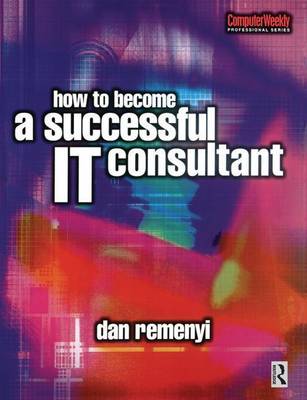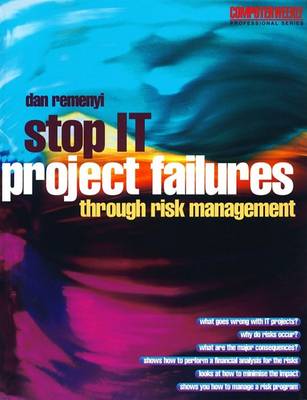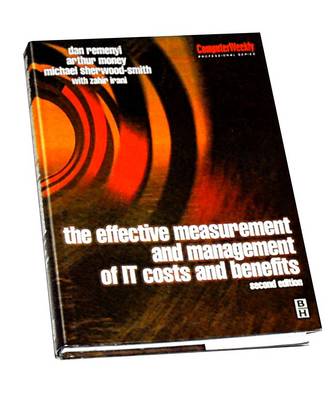Computer Weekly Professional
3 total works
How to Become a Successful It Consultant
by D. Remenyi and Professor Dan Remenyi
Published 1 January 2013
This book is about information systems development failures and how to avoid them.
It considers what goes wrong with information systems development projects and what actions may be taken to avoid potential difficulties.The reduction of the impact,or even the elimination of the problems,is discussed in terms of an information systems risk management programme.
Stop I.T.Project failure helps to ensure that IS project managers are successful in helping to deliver application systems. However, IS development risk can never be entirely eliminated and consequently the practitioner needs to bear in mind that an IS development project is never without risk, and hence there is a continuing potential for something to go wrong.
The book covers the key issues and variables and makes specific practical suggestions about the good management practice that is required to implement IS project risk processes.
Dr. Dan Remenyi has spent more than 25 years working in the field of corporate computers and information systems. He has worked with computers as an IS professional, business consultant and user. In all these capacities he has been primarily concerned with benefit realisation and obtaining the maximum value for money from the organisations' information systems investment and effort. He has worked extensively in the field of information systems project management, specialising in the area of project risk identification and management. He has written a number of books and papers in the field of IT management and regularly conducts courses and seminars as well as working as a consultant in this area. Dr.Dan Remenyi holds a B.Soc.Sc., an MBA and a PhD. He is a Visiting Professor at Chalmers University of Technology in Gothenberg, Sweden and an associate member of faculty at Henley Management College in the United Kingdom.
It considers what goes wrong with information systems development projects and what actions may be taken to avoid potential difficulties.The reduction of the impact,or even the elimination of the problems,is discussed in terms of an information systems risk management programme.
Stop I.T.Project failure helps to ensure that IS project managers are successful in helping to deliver application systems. However, IS development risk can never be entirely eliminated and consequently the practitioner needs to bear in mind that an IS development project is never without risk, and hence there is a continuing potential for something to go wrong.
The book covers the key issues and variables and makes specific practical suggestions about the good management practice that is required to implement IS project risk processes.
Dr. Dan Remenyi has spent more than 25 years working in the field of corporate computers and information systems. He has worked with computers as an IS professional, business consultant and user. In all these capacities he has been primarily concerned with benefit realisation and obtaining the maximum value for money from the organisations' information systems investment and effort. He has worked extensively in the field of information systems project management, specialising in the area of project risk identification and management. He has written a number of books and papers in the field of IT management and regularly conducts courses and seminars as well as working as a consultant in this area. Dr.Dan Remenyi holds a B.Soc.Sc., an MBA and a PhD. He is a Visiting Professor at Chalmers University of Technology in Gothenberg, Sweden and an associate member of faculty at Henley Management College in the United Kingdom.
Effective Measurement and Management of IT Costs and Benefits
by D. Remenyi, etc., Arthur Money, and Alan Twite
Published 1 May 1995
The rapidly increasing level of expenditure on information technology in most organisations is one reason why IT benefits management has become an important business concern. Top management have begun to insist that much more attention be paid to the economic aspects of information systems. This had led to a great demand for a comprehensive IT metric. However, little attempt has yet been made to produce a complete approach to understanding the economics of how information is used to boost the efficiency or effectiveness of companies. This second and fully updated edition of "The Effective Measurement and Management of IT Costs and Benefits" provides a basic framework for an understanding of the economic issues of information as well as some suggestions as to how a company's IT efforts may be appraised. The authors discuss a number of different evaluation concepts as well as reviewing several approaches to cost and benefit measurement. An IT Assessment Metric (ITAM) is proposed which allows firms to measure their progress towards obtaining maximum value from their information technology efforts.
A professional level book for the computer "Weekly Professional Series", it provides a basic framework for an understanding of the economic issues of information as well as some suggestions as to how a company's IT efforts may be appraised.
A professional level book for the computer "Weekly Professional Series", it provides a basic framework for an understanding of the economic issues of information as well as some suggestions as to how a company's IT efforts may be appraised.


